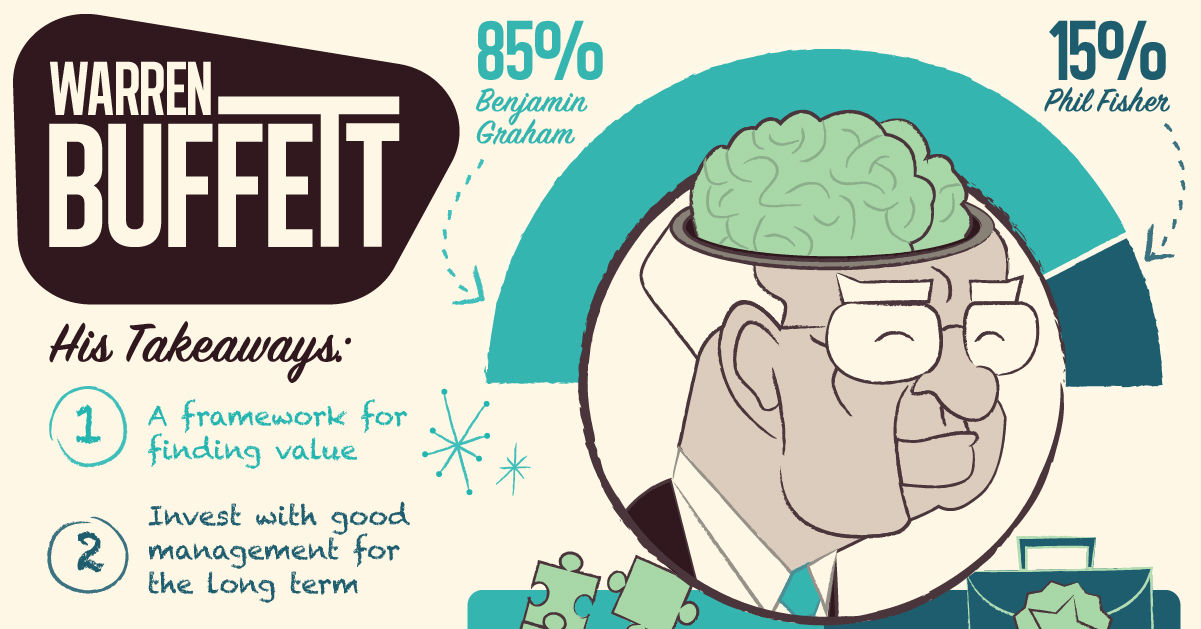Markets
Inside Warren Buffett’s Brain
What springs to mind when you think of legendary investor Warren Buffett?
For some, it’s his humble Omaha origins or his long-lasting obsession with Coca-Cola. For other people, it’s Buffett’s impeccable investing track record and extraordinary wealth that make a lasting impression.
While these are all legitimate connections to make with the Buffett name, perhaps he is most synonymous with the discipline of value investing – the style and mindset Buffett has made famous over the decades.
The Warren Buffett Series
Part 2: Inside Buffett’s Brain
Today’s infographic provides a deep dive into Warren Buffett’s brain, and it explains everything about his investing philosophy, along with the framework he uses to evaluate potential opportunities.
It’s the second part of the Warren Buffett Series, which we’ve done in partnership with finder.com, a personal finance site that helps people make better decisions – whether they want to jump on the cryptocurrency craze or follow Buffett’s more traditional path to financial success.

Note: Stay tuned for future parts with our free mailing list.
Warren Buffett’s investment philosophy is well-known.
He famously focuses on the intrinsic value of companies, and he buys stocks when they are “on sale”. Buffett’s not afraid to accumulate big positions in companies he likes – and his favorite holding period is “forever”.
While this formula may seem simple on paper, it’s extremely nuanced and complex in practice.
How Does Buffett’s Brain Work?
Warren Buffett has said that he borrows 85% of his investing style from Benjamin Graham, and 15% from Phil Fisher.
Benjamin Graham:
The godfather of value investing gave Buffett a framework for finding undervalued assets and companies.
Phil Fisher:
The famous growth investor showed Buffett the importance of investing with good management teams.
According to writer Robert Hagstrom, Buffett applies these ideas by focusing on four key principles of investing:
1. Analyze a stock as a business
Have the priorities of a business owner and look the company from a long-term perspective.
Is it increasing its intrinsic value? Would you want to own the entire company?
2. Ensure a “margin of safety”
Buffett considers “margin of safety” the three most important words in investing.
In other words, does a company have more intrinsic value than book value?
3. Manage a focused portfolio
Concentrate on a few stocks that will provide above-average returns over time. Buffett suggests investors think of this as owning a “punch card” with just 20 investment choices that can be made over a lifetime.
4. Protect yourself from Mr. Market
Mr. Market can be speculative and emotional, and he should not be relied upon as a predictor of future prices.
Instead, take advantage of Mr. Market periodically, whenever there is a fire sale.
Buffett’s Investment Criteria
Here are 12 key factors Warren Buffett considers when looking at potential opportunities:
1. Simplicity
Is the business easy to understand?
2. Operating History
Has the business been around for a long time, with a consistent operating history?
3. Long-Term Prospects
Is there reason to believe that the business will be able to sustain success in the long-term?
4. Rational Decisions
Is management wise when it comes to reinvesting earnings or returning profits to shareholders as dividends?
5. Candidness
Does the management team admit mistakes? Are they honest with shareholders?
6. Resisting the “Institutional Imperative”
Can the company resist temptations created by institutional dynamics, such as imitating peer companies, or resist changes in direction?
7. Profit Margins
Does the company have high profit margins?
8. Return on Equity
What is the return on equity (ROE) of the business?
9. Owners Earnings
What is the company’s ability to generate cash for shareholders, who are the residual owners? This is technically defined as free cash flow to equity (FCFE).
10. One Dollar Premise
For every dollar retained from net income, does the company create at least one dollar of market value?
11. Intrinsic Value
What is the value of the future owners’ earnings, discounted back to the present?
12. Margin of Safety
What’s the chance you’ll lose money on the stock, in the long run, if you buy it at today’s price?
Or to sum all of these ideas up succinctly, here’s a quote from the man himself.
My strategy is to find a good business – and one that I can understand why it’s good – with a durable, competitive advantage, run by able and honest people, and available at a price that makes sense.
– Warren Buffett
Other Notes
Part 3 of the Warren Buffett Series will be released in late February 2018.
Credits: This infographic would not be possible without the great biographies done by Roger Lowenstein (Buffett: The Making of an American Capitalist) and Alice Schroeder (The Snowball), as well as numerous other sources cataloging Buffett’s life online.
Economy
Economic Growth Forecasts for G7 and BRICS Countries in 2024
The IMF has released its economic growth forecasts for 2024. How do the G7 and BRICS countries compare?

G7 & BRICS Real GDP Growth Forecasts for 2024
The International Monetary Fund’s (IMF) has released its real gross domestic product (GDP) growth forecasts for 2024, and while global growth is projected to stay steady at 3.2%, various major nations are seeing declining forecasts.
This chart visualizes the 2024 real GDP growth forecasts using data from the IMF’s 2024 World Economic Outlook for G7 and BRICS member nations along with Saudi Arabia, which is still considering an invitation to join the bloc.
Get the Key Insights of the IMF’s World Economic Outlook
Want a visual breakdown of the insights from the IMF’s 2024 World Economic Outlook report?
This visual is part of a special dispatch of the key takeaways exclusively for VC+ members.
Get the full dispatch of charts by signing up to VC+.
Mixed Economic Growth Prospects for Major Nations in 2024
Economic growth projections by the IMF for major nations are mixed, with the majority of G7 and BRICS countries forecasted to have slower growth in 2024 compared to 2023.
Only three BRICS-invited or member countries, Saudi Arabia, the UAE, and South Africa, have higher projected real GDP growth rates in 2024 than last year.
| Group | Country | Real GDP Growth (2023) | Real GDP Growth (2024P) |
|---|---|---|---|
| G7 | 🇺🇸 U.S. | 2.5% | 2.7% |
| G7 | 🇨🇦 Canada | 1.1% | 1.2% |
| G7 | 🇯🇵 Japan | 1.9% | 0.9% |
| G7 | 🇫🇷 France | 0.9% | 0.7% |
| G7 | 🇮🇹 Italy | 0.9% | 0.7% |
| G7 | 🇬🇧 UK | 0.1% | 0.5% |
| G7 | 🇩🇪 Germany | -0.3% | 0.2% |
| BRICS | 🇮🇳 India | 7.8% | 6.8% |
| BRICS | 🇨🇳 China | 5.2% | 4.6% |
| BRICS | 🇦🇪 UAE | 3.4% | 3.5% |
| BRICS | 🇮🇷 Iran | 4.7% | 3.3% |
| BRICS | 🇷🇺 Russia | 3.6% | 3.2% |
| BRICS | 🇪🇬 Egypt | 3.8% | 3.0% |
| BRICS-invited | 🇸🇦 Saudi Arabia | -0.8% | 2.6% |
| BRICS | 🇧🇷 Brazil | 2.9% | 2.2% |
| BRICS | 🇿🇦 South Africa | 0.6% | 0.9% |
| BRICS | 🇪🇹 Ethiopia | 7.2% | 6.2% |
| 🌍 World | 3.2% | 3.2% |
China and India are forecasted to maintain relatively high growth rates in 2024 at 4.6% and 6.8% respectively, but compared to the previous year, China is growing 0.6 percentage points slower while India is an entire percentage point slower.
On the other hand, four G7 nations are set to grow faster than last year, which includes Germany making its comeback from its negative real GDP growth of -0.3% in 2023.
Faster Growth for BRICS than G7 Nations
Despite mostly lower growth forecasts in 2024 compared to 2023, BRICS nations still have a significantly higher average growth forecast at 3.6% compared to the G7 average of 1%.
While the G7 countries’ combined GDP is around $15 trillion greater than the BRICS nations, with continued higher growth rates and the potential to add more members, BRICS looks likely to overtake the G7 in economic size within two decades.
BRICS Expansion Stutters Before October 2024 Summit
BRICS’ recent expansion has stuttered slightly, as Argentina’s newly-elected president Javier Milei declined its invitation and Saudi Arabia clarified that the country is still considering its invitation and has not joined BRICS yet.
Even with these initial growing pains, South Africa’s Foreign Minister Naledi Pandor told reporters in February that 34 different countries have submitted applications to join the growing BRICS bloc.
Any changes to the group are likely to be announced leading up to or at the 2024 BRICS summit which takes place October 22-24 in Kazan, Russia.
Get the Full Analysis of the IMF’s Outlook on VC+
This visual is part of an exclusive special dispatch for VC+ members which breaks down the key takeaways from the IMF’s 2024 World Economic Outlook.
For the full set of charts and analysis, sign up for VC+.
-

 Markets1 week ago
Markets1 week agoU.S. Debt Interest Payments Reach $1 Trillion
-

 Markets2 weeks ago
Markets2 weeks agoRanked: The Most Valuable Housing Markets in America
-

 Money2 weeks ago
Money2 weeks agoWhich States Have the Highest Minimum Wage in America?
-

 AI2 weeks ago
AI2 weeks agoRanked: Semiconductor Companies by Industry Revenue Share
-

 Markets2 weeks ago
Markets2 weeks agoRanked: The World’s Top Flight Routes, by Revenue
-

 Countries2 weeks ago
Countries2 weeks agoPopulation Projections: The World’s 6 Largest Countries in 2075
-

 Markets2 weeks ago
Markets2 weeks agoThe Top 10 States by Real GDP Growth in 2023
-

 Money2 weeks ago
Money2 weeks agoThe Smallest Gender Wage Gaps in OECD Countries




















